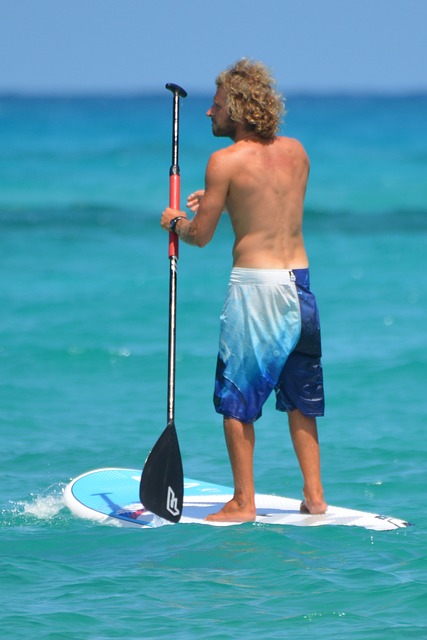When choosing a surfboard as a beginner, it's essential to select one with a foam core that provides optimal buoyancy and ease of handling. A well-suited board for novices will have a high-density foam core, ensuring durability and longevity while minimizing concerns over equipment damage during the learning process. These boards are designed with soft rails and a wider outline to promote stability, making it easier to paddle, catch waves, and develop surfing skills. They're ideal for small to mid-sized waves and come with a robust outer layer, typically made of fiberglass or epoxy, which protects against wear and tear. This combination of features makes them both forgiving for beginners and economical for those who are progressing in their surfing journey.
Exploring the realm of wave riding, lightweight foam core surfboards have emerged as a game-changer for beginners. This article demystifies their construction and benefits, guiding novices through the essentials of selecting the perfect board, understanding foam types, and maintaining it for enduring use. From unlocking their potential to top recommendations, we cover everything needed to start your surfing journey on a note of ease and excitement. Join us as we dive into the anatomy and advantages of these versatile surfboards designed specifically with the newcomer in mind.
Unlocking the Potential of Lightweight Foam Core Surfboards for Beginners

Lightweight foam core surfboards represent a significant advancement in the sport, particularly for novice surfers. These boards are engineered with high-density foam cores that provide exceptional buoyancy and stability, making them ideal for those just starting out. The lightweight nature of these surfboards allows beginners to paddle into waves with ease, a critical skill as they develop their surfing technique. The core’s resilience ensures that even when catching larger waves, the board maintains its shape and performance, offering a safe and confidence-building experience. Additionally, the foam core technology results in a more sustainable option compared to traditional wooden or fiberglass boards, making it an eco-friendly choice for new surfers who are often most concerned with safety and affordability. These surfboards for beginners are designed to offer a forgiving ride, reducing the likelihood of wipeouts and enhancing the learning process. Their versatility also means they can be ridden in various wave conditions, which is particularly beneficial for those learning in dynamic environments where surf can vary throughout the day or season. As a result, foam core surfboards are not only accessible to newcomers but also contribute to the broader sustainability goals of the surfing community.
The Anatomy of a Foam Core Surfboard: What Makes It Ideal for Novices

A foam core surfboard represents a pivotal innovation in the world of wave riding, particularly suited for those embarking on their surfing journey. The anatomy of this board begins with its core, which is typically composed of polyurethane or polystyrene foam. This material offers a superior balance between weight and buoyancy, making it an excellent choice for novices who are still mastering the fundamentals of paddling and standing up on a board. The high-density foam ensures that the surfboard floats well, allowing beginners to catch waves with relative ease. Additionally, the lightweight nature of foam core surfboards means that they are more manageable in the water, reducing fatigue and making long sessions of practice less taxing.
The construction of a foam core surfboard is designed with the beginner surfer in mind. The deck, or top side, often features a soft, epoxy skin that provides a comfortable platform for learning. This skin also helps to absorb impacts from the occasional wipeout, which are inevitable for those new to the sport. The stringer running through the board’s length adds structural integrity without significantly increasing weight. The rails, or edges, of these boards are typically softer, offering more forgiveness and making it harder to “pearl” or nose dive, which can happen when beginners attempt sharp turns too early in their learning curve. The fin setup on foam core surfboards is often simplified to a single fin, sometimes with the option for a removable fin system, which allows for adjustments according to wave conditions and personal preference as the surfer progresses. This adaptability underscores the advantage of choosing a foam core surfboard as a beginner’s surfboard, catering to the evolving needs of the learner without compromising on ease of use or safety.
The Advantages of Using Foam Core in Surfboard Design

Lightweight foam core has revolutionized the design and construction of surfboards, particularly for beginners. The unique properties of this material provide several advantages that enhance the overall surfing experience for those who are new to the sport. One of the most significant benefits is the weight reduction it offers. Traditional materials like balsa wood or polyurethane foam can be heavy, making it more challenging for beginners to paddle and maneuver. In contrast, foam core materials are engineered to be significantly lighter, allowing novices to achieve greater buoyancy without feeling weighed down. This lightweight characteristic also contributes to the board’s increased responsiveness and paddling efficiency, both of which are crucial skills for beginner surfers learning to catch waves.
Furthermore, foam core surfboards offer unparalleled durability despite their lighter weight. They can withstand the rigors of learning without frequent repairs or replacements, making them an economical choice for those just starting out. The consistency and uniformity of the material also ensure a more reliable performance in various conditions, which is essential when gaining confidence on the water. Additionally, the customizability of foam core allows for tailored designs that cater to the specific needs of beginner surfers, whether it’s shaping for better stability or adjusting for different wave sizes. This adaptability makes foam core an optimal choice for anyone looking to explore the world of surfing without the constraints of heavier, more traditional board materials.
Choosing the Right Size and Shape for Your Beginner's Foam Core Surfboard

When selecting a lightweight foam core surfboard tailored for beginners, the importance of the right size and shape cannot be overstated. For novice surfers, a board that is too large or unwieldy can be overwhelming and hinder progress, while one that is too small may not provide enough stability and floatation. As such, beginner surfers should opt for a foam core surfboard that offers a balance between manageability and buoyancy.
The ideal dimensions for a beginner’s foam core surfboard typically range from 7 to 9 feet in length. This size allows for ease of paddling and catching waves, which are critical skills for those new to the sport. Additionally, a wider board with a rounded pin tail is often recommended for beginners as it provides more stability and makes it easier to trim along the wave face without losing control. The thickness of the board should also be considered; a thicker board offers more buoyancy, which can be beneficial for those who weigh more or are still mastering their balance on the water.
Choosing the right shape and size of your foam core surfboard is a pivotal decision that will influence your learning curve and overall enjoyment of the sport. A well-selected board will not only enhance your initial experience but also set a solid foundation for your progression as you advance beyond beginner status. Remember to consider the type of waves you’ll primarily be surfing, as this too can affect the ideal shape and size of your foam core surfboard. With the right board underfoot, the learning journey for beginners can be both enjoyable and rewarding.
Understanding Different Types of Foam Cores: Their Impact on Performance

When selecting a lightweight foam core for a surfboard tailored to beginners, it’s crucial to understand the various types available and their respective impacts on performance. Polyurethane (PU) foam cores are a popular choice due to their excellent balance of weight, durability, and buoyancy, making them ideal for those new to the sport. PU foam provides a responsive feel that can help beginners develop their skills without being overwhelmed by the challenges of handling a heavier board. Its ability to offer both floatation and maneuverability is particularly beneficial for novices who are still mastering the basics of paddling, standing, and turning on a surfboard.
Another type of foam core often used in beginner surfboards is polystyrene (PS) foam. This material is lighter than PU foam, which can be advantageous for beginners who might appreciate a board that’s easier to paddle into waves. Polystyrene foam cores also tend to have excellent consistency throughout the board, which contributes to a more uniform performance. However, it’s less durable than PU, so while it may offer a lighter weight option, it might require more frequent replacement over time. The choice between PU and PS foam cores for a beginner’s surfboard depends on the individual’s size, skill level, and the types of waves they will encounter most often. Both options can serve beginners well, but understanding the differences allows for a more informed decision that aligns with one’s specific needs and preferences in the water.
The Importance of Density and Construction in Foam Core Surfboards

When selecting a surfboard, particularly for beginners, the material and construction of the foam core play pivotal roles in determining the board’s performance and user-friendliness. Density in foam cores is a critical factor as it influences the buoyancy and durability of the surfboard. High-density foam offers superior floatation, making it an excellent choice for learners who may need extra support as they get accustomed to the waves. This density also contributes to the longevity of the board, ensuring that beginners can practice without the constant worry of damaging their equipment.
In addition to density, the construction method used in shaping and finishing foam core surfboards significantly impacts their overall quality and responsiveness. A well-constructed foam core board, often reinforced with fiberglass or epoxy resin, provides a sturdy yet flexible platform that can adapt to various conditions. This robustness is complemented by the strategic placement of wood stringers or carbon fiber rods, which enhance the board’s torsional strength and energy transfer from wave to board. For beginners, this means a surfboard that not only offers stability and ease of use but also has the potential to grow with their skills as they advance beyond the basics of surfing.
Top Brands and Models of Foam Core Surfboards for Beginners

For those embarking on their surfing journey, selecting a suitable surfboard is paramount to a smooth learning curve and enjoyable experience. A lightweight foam core surfboard is often the recommended choice for beginners due to its buoyancy and forgiving nature. Among the top brands that cater to novices with high-quality foam core models are BIC Surf, which offers the Softboard Series, providing excellent stability and ease of use for newcomers. Another notable brand is South Core, whose surfboards are engineered with a strong EPS core wrapped in a lightweight and durable wooden stringer for enhanced performance and resilience against dings.
In addition to BIC Surf and South Core, Lighthouse Surf Designs stands out for its beginner-friendly foam core boards that strike an ideal balance between floatation, maneuverability, and durability. Their surfboards are designed with a soft top deck and triple fin setup, making them user-friendly and suitable for learning the fundamentals of surfing in various conditions. Similarly, Wavetrek Surfcraft is renowned for its innovative foam core constructions that offer a responsive yet gentle ride for beginners. Their boards are crafted with attention to detail, ensuring a board that’s easy to handle and long-lasting. These brands exemplify the best options in foam core surfboards for those starting their surfing adventure.
Tips for Maintaining Your Foam Core Surfboard to Ensure Long-Term Use

When investing in a foam core surfboard, especially one designed for beginners, it’s crucial to maintain its integrity and performance over time. Proper care ensures that your board remains in excellent condition, providing safety and enjoyment during every session on the waves. Firstly, always rinse your surfboard with fresh water after each use to remove saltwater residue and sand, which can accelerate degradation. Use a soft brush or sponge with a mild detergent solution to gently clean the deck and the rail lines where dirt tends to accumulate. It’s also important to avoid using harsh chemicals or abrasive pads that could damage the foam core and finish.
For long-term use, store your foam core surfboard in a cool, shaded area, away from direct sunlight and extreme temperatures, as these conditions can compromise the structural integrity of the board. Adequate ventilation is key to prevent warping or delamination. Additionally, ding repairs should be addressed promptly to maintain the board’s shape and watertightness. Use a repair kit specifically designed for foam core boards to ensure a proper fix. Regularly inspect your surfboard for any signs of damage, such as dings or stress marks, and address them immediately. By following these maintenance practices, your beginner-friendly foam core surfboard will serve you well, offering the stability and buoyancy needed to progress in the sport while remaining a reliable companion on the water.
FAQs: Answering Common Questions About Foam Core Surfboards for Beginners

When selecting a surfboard for beginners, lightweight foam core boards often stand out as an excellent choice due to their buoyancy and ease of handling in the water. These boards are specifically designed with soft rails and a wider outline to provide stability and make it simpler for novices to paddle into waves without feeling overwhelmed. A common question among those new to surfing is how foam core surfboards can handle different wave conditions. Typically, these boards perform well in small to mid-sized waves, offering a gentle ride that allows beginners to get the hang of standing up and riding the wave before progressing to more advanced board types for bigger swells. Another frequently asked question pertains to the durability of foam core surfboards. Despite their lightweight nature, these boards are built to withstand the rigors of learning, with a high-density foam core that is sandwiched between two strong skins, often made from fiberglass or epoxy, which protects against dings and dents that can occur during the learning process. This construction also ensures that the board maintains its shape and performance over time, making it a cost-effective option for those just starting out in the sport of surfing.
